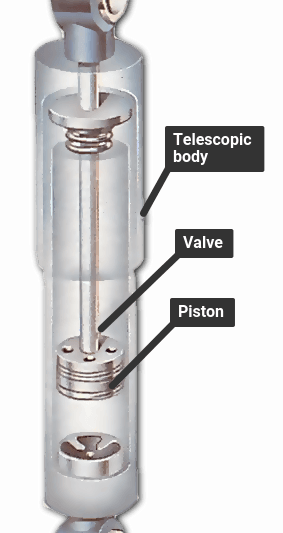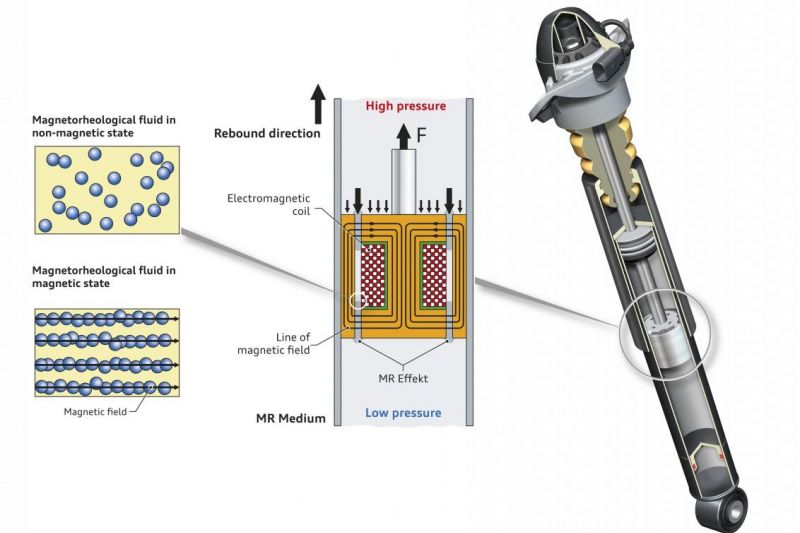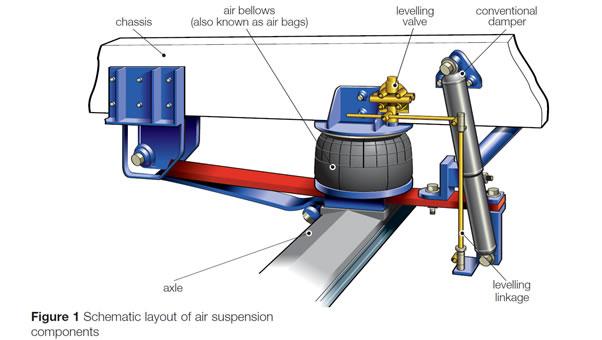In the past, cars were offered with a fixed suspension setup. Engineers determined what the car would be most commonly used for, and developed a suspension that would meet those needs best.
This inherently involved a compromise, as cars designed to be luxurious offered a soft ride at the expense of good handling, and vice versa.
The idea behind adaptive suspension is to eliminate any trade-offs between ride and handling by allowing the customer to choose the settings that best suit their driving environment. The three most popular solutions offered by carmakers today are electronic damper control, manually adjustable suspension, and air suspension.
Electronic damper control
Dampers (also known as shock absorbers) are a critical part of a car’s suspension. They work to dissipate energy and aim to reduce any bounciness that would come with a car only having springs as part of its suspension setup.
To do this, dampers consist of a piston inside a cylinder filled with thick, pressurised oil. Small holes within the piston allow the oil to flow through. If a car travels through a bump, the piston compresses, with the flow of oil allowing kinetic energy from the bump to dissipate as thermal energy.
The most common adaptive suspensions systems today aim to electronically control this damping process and ensure that the right amount of damping force is available for every driving situation. This is done either through the use of motors to adjust the opening of the damper flow valve, or through the use of electromagnets.
Systems such as the DCC (Dynamic Chassis Control) used in various Volkswagen products such as the Golf R work by progressively opening and closing the damper flow valve and other openings.
Opening the valve causes oil to flow through more easily, offering greater compression and therefore a softer ride when the driver is in Comfort mode, whilst closing the valve restricts oil flow, creating the opposite effect in Sport mode.
Electromagnetic systems such as Audi’s Magnetic Ride Control aim to achieve a similar effect, but through the use of what is known as a magnetorheological fluid. This acts as a replacement for plain oil in a standard damper, and is a fluid with metal particles suspended within.
The damper piston includes a coil that acts as an electromagnet when an electric current is passed through it. As this happens, the metal particles within the fluid are aligned, greatly increasing its thickness (viscosity) and effectively stiffening the suspension to reduce body roll.
The primary advantage over electromagnetic systems over mechanical systems such as the DCC described above has to do with their responsiveness.
Other popular names for adaptive suspension systems include: MagneRide (Ford), Adaptive Dynamics (Jaguar), Porsche Active Suspension Management – PASM, Adaptive Variable Suspension – AVS (Lexus) and Four-C Chassis Control (Volvo).
Manually-adjustable suspension
Manually-adjustable adaptive suspension is perhaps the simplest, but also the least common, type of adaptive suspension.
In these cases, the driver is able to hoist the car on a jack and manually adjust the opening of the damper flow valve through a range of settings by rotating a knob at each shock absorber.
Very few production cars currently offered with manually-adjustable suspension. It’s usually reserved for track specials, although it’s also fitted to the Polestar 1 and 2.
Adaptive air suspension
Air suspension systems replace the coil springs in a conventional setup with inflatable rubber membranes that contain pressurised air. As the rubber membrane inflates or deflates, the ride height of the vehicle can be changed.
There are four key components to any air suspension system. These are an air compressor that can supply air to a reservoir, the rubber membranes that use this air, and a series of ride height sensors to determine the ride height of the vehicle at each corner.
Air suspension systems usually retain the dampers found in typical automotive suspension systems.
These systems can come in both closed and open varieties. Notice the hissing sound whenever you catch a bus as its ride height lowers? That’s characteristic of an open air suspension system, whereby the rubber membrane simply lets excess air into the atmosphere when depressurising.
A closed air suspension system is a more modern alternative where air can be returned to the reservoir when the rubber membrane deflates to facilitate quieter, more efficient, quicker changes in ride height.
The ability for air suspension systems to change the ride height of the vehicle also brings other benefits with regard to aerodynamics, load handling benefits as well as potentially improved off-road capabilities for 4WD vehicles.
An air suspension system is able to compensate for any heavy loads that might be placed in the back of a vehicle, adjusting the ride height to ensure that the vehicle sits flat and does not sag. In addition, modern vehicles equipped with air suspension systems can automatically lower their ride height at higher speeds to improve efficiency and handling.
Other technologies
Hydropneumatic suspension, championed by Citroen with its Hydractive brand of suspension systems, uses a combination of hydraulic fluid and nitrogen filled spheres that are swapped in or out to change the firmness of the ride, to achieve similar overall benefits to standard air suspension systems.
Although no longer available in Citroen vehicles sold today, Mercedes offers its own, advanced version in top of the range vehicles such as the S-Class known as Active Body Control. A more recent development with this system is the introduction of an Active Curve Tilting function which enables the car to lean in corners similar to a motorbike in turns.
Mercedes claims this system further improves comfort by reducing the forces experienced by occupants in the cabin.
Predictive suspension systems are another new suspension technology. Called the Flagbearer system in the latest Rolls-Royce Phantom and Ghost, similar systems are also offered in Mercedes-Benz, BMW, Genesis and Audi vehicles.
These combine an adaptive suspension system with cameras and other sensors that can detect bumps and potholes in advance, and thereby prepare the car by either softening or increasing the suspension at a particular wheel to minimise its impact.
Mercedes’ latest E-Active Body Control, also known as the ‘dancing suspension’, combines air suspension with hydropneumatics to offer even greater control of the spring and damping forces at each wheel, and improved off-road capabilities.












